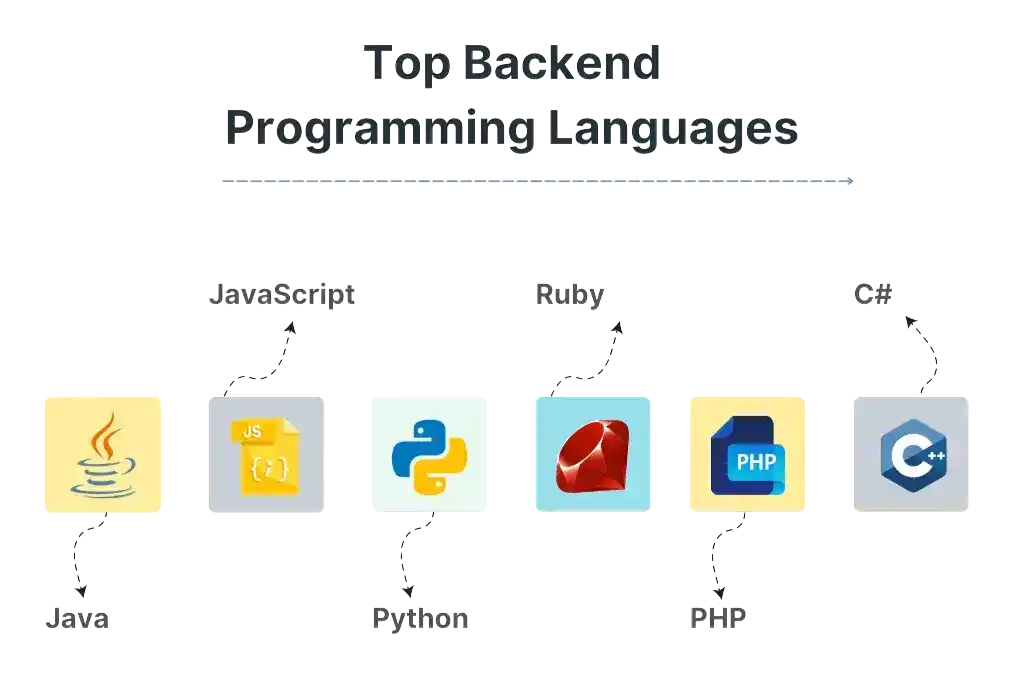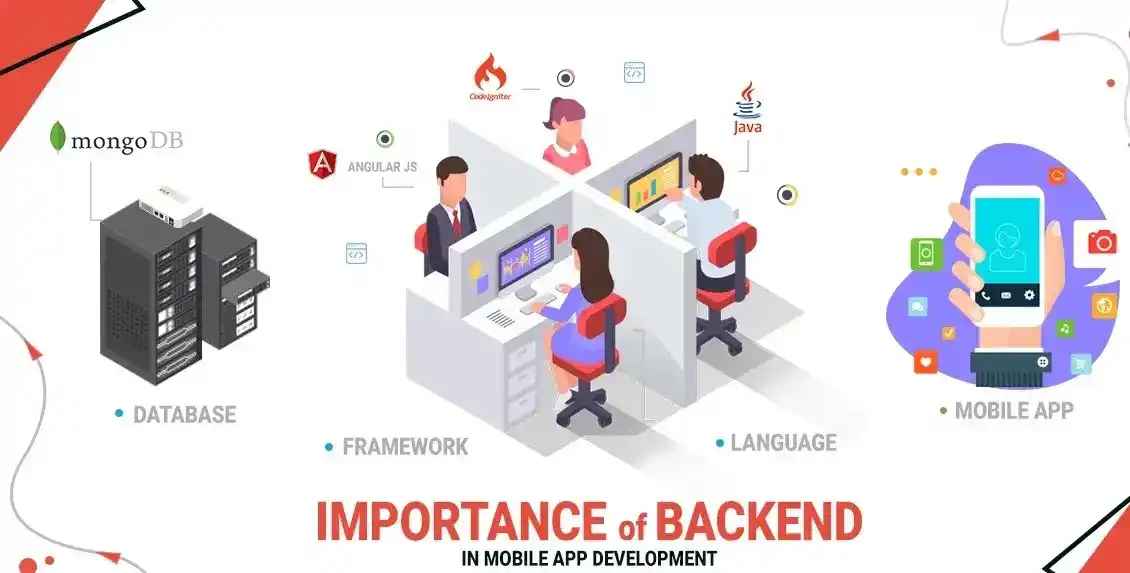Top Backend Technologies in 2025
Updated on : 09 April, 2025

Image Source: facebook.com
Table Of Contents
- 1. Introduction
- 2. Why Backend Technology Matters
- 3. Comparison Table: Backend Tech Overview
- 4. Node.js
- 5. Django
- 6. Laravel
- 7. Spring Boot
- 8. Ruby on Rails
- 9. Flask
- 10. Express.js vs Koa.js: A Quick Comparison
- 11. ASP.NET Core
- 12. NestJS
- 13. Emerging Backend Trends
- 14. How Hexadecimal Software Can Help
- 15. FAQs
- 16. Conclusion
Table Of Contents
Introduction
Backend technologies are the backbone of modern digital applications. As user demands for speed, scalability, and real-time experiences increase, choosing the right backend stack becomes essential. Here's a detailed breakdown of the top backend technologies in 2025, including comparisons, best use cases, industry applications, and performance insights.
Backend development focuses on the server-side logic of web and mobile applications. It handles everything from database operations and API integrations to authentication, authorization, and application performance. A robust backend ensures your application performs efficiently under load and delivers data securely.
Why Backend Technology Matters
Your choice of backend stack impacts:
- Performance: How fast your application responds to user interactions.
- Scalability: How well it handles traffic as your user base grows.
- Security: How vulnerable your app is to threats.
- Developer Efficiency: Ease of writing, testing, and deploying backend code.
- Integration: Compatibility with frontend technologies, databases, cloud services, and APIs.

Image Source: google
Comparison Table: Backend Tech Overview
| Technology | Language | Architecture | Ideal Use Case | Scalability | Popularity |
|---|---|---|---|---|---|
| Node.js | JavaScript | Event-driven | Real-time apps, APIs | High | ★★★★★ |
| Django | Python | MVT | CMS, fintech, analytics | High | ★★★★☆ |
| Laravel | PHP | MVC | Web apps, eCommerce | Medium | ★★★★☆ |
| Spring Boot | Java | Microservices | Enterprise-grade systems | High | ★★★★☆ |
| Ruby on Rails | Ruby | MVC | MVPs, rapid development | Medium | ★★★★☆ |
| Flask | Python | Micro | Lightweight APIs, ML apps | Medium | ★★★★☆ |
| Express.js | JavaScript | Middleware | REST APIs, microservices | High | ★★★★★ |
| Koa.js | JavaScript | Middleware | Next-gen web backends | High | ★★★★☆ |
| ASP.NET Core | C# | MVC/Web API | Enterprise, cloud-native | High | ★★★★☆ |
| NestJS | TypeScript | Modular | Complex scalable solutions | High | ★★★★☆ |

Want expert advice on choosing the right backend tech?
Node.js
Parent Company: OpenJS Foundation (originally by Joyent)
Developer: Ryan Dahl
First Released: 2009
Node.js excels with its non-blocking, event-driven architecture, making it perfect for real-time applications like chat apps, online games, and streaming platforms. Its extensive npm ecosystem supports quick development and seamless integrations.
Key Features:
- Non-blocking I/O: Handles multiple requests concurrently, improving efficiency.
- V8 Engine: High performance with Chrome's V8 JavaScript engine.
- NPM: A vast repository of open-source packages for almost any need.
- JSON Support: Native support for JSON makes it excellent for API development.
- Single Threaded: Simplified concurrency model due to single-threaded nature.
| Strengths | Use Cases |
|---|---|
| High-speed I/O operations | Real-time chat applications |
| Large developer community | API backends for mobile apps |
| Great for full-stack JS projects | Streaming platforms |
Django
Parent Organization: Django Software Foundation
Developers: Adrian Holovaty and Simon Willison
First Released: 2005
Django is a high-level Python web framework focused on rapid development and clean, pragmatic design. It includes features like authentication and ORM to facilitate complex tasks.
Key Features:
- ORM (Object-Relational Mapping): Simplifies database interactions.
- Admin Interface: Auto-generated admin panel for easy content management.
- Security: Strong built-in protection against common web vulnerabilities.
- Middleware Support: Flexible support for adding middleware for request processing.
- Template Engine: Built-in template engine for generating dynamic web pages.
| Strengths | Use Cases |
|---|---|
| Batteries-included approach | Content management systems |
| Robust security features | Financial services |
| Scalable and secure | Data analytics platforms |
Mobile App Development Services
From idea to launch, Hexadecimal delivers high-performance mobile apps for iOS and Android. Whether it's native, hybrid, or cross-platform, they craft intuitive, scalable apps tailored to your business goals.
Laravel
Parent Company: Laravel LLC
Developer: Taylor Otwell
First Released: 2011
Laravel is a PHP framework offering a developer-friendly experience through features like Blade templating, Eloquent ORM, and queue systems.
Key Features:
- Blade Templating Engine: Allows easy creation of dynamic views.
- Eloquent ORM: Offers a straightforward method for database interactions.
- Artisan Console: Contains helpful commands to streamline development.
- Testing Support: Robust testing framework for writing unit and integration tests.
- Task Scheduling: Simplifies scheduling recurring tasks with a fluent API.
| Strengths | Use Cases |
|---|---|
| Elegant syntax and structure | eCommerce platforms |
| Built-in authentication | Social networking sites |
| Great for RESTful APIs | SaaS applications |
Spring Boot
Parent Company: VMware (originally by Pivotal)
Developer: Spring Team
First Released: 2014
Spring Boot simplifies Java backend development with auto-configuration and production-ready defaults, widely used in large-scale enterprise environments.
Key Features:
- Auto-Configuration: Automatically configures the application based on its dependencies.
- Embedded Servers: Simplifies deployment with embedded servers like Tomcat, Jetty, or Undertow.
- Spring Data: Streamlines data access and management.
- Actuator: Provides built-in endpoints for monitoring and managing the application.
- Security: Robust security framework for authentication and authorization.
| Strengths | Use Cases |
|---|---|
| Enterprise-grade security | Banking and finance |
| Microservices architecture | Cloud-native applications |
| Robust dependency injection | Large-scale enterprise systems |
Ruby on Rails
Parent Company: Basecamp
Developer: David Heinemeier Hansson
First Released: 2004
Rails focuses on convention over configuration to accelerate development, making it popular among startups for rapid MVP creation.
Key Features:
- Convention over Configuration: Reduces decision-making for faster development.
- Active Record ORM: Facilitates database interactions with minimal code.
- Scaffolding: Automatically generates models, views, and controllers.
- RESTful Architecture: Encourages building applications following REST principles.
- Testing Framework: Integrated testing framework for writing automated tests.
| Strengths | Use Cases |
|---|---|
| Rapid development cycle | Startups and MVPs |
| Strong community support | Social media platforms |
| Convention over configuration | E-commerce sites |
Flask
Parent Organization: Pallets Projects
Developer: Armin Ronacher
First Released: 2010
Flask provides flexibility and control with a minimalistic setup, making it suitable for microservices, APIs, and applications where fine-grained control is necessary.
Key Features:
- Lightweight: Simple core makes it easy to understand and maintain.
- Flexible: Unopinionated, allowing developers to select preferred tools and libraries.
- WSGI Compliant: Compatible with a variety of web servers.
- Jinja2 Templating: Powerful templating engine for generating dynamic content.
- Extensible: Supports extensions for adding features like ORM, authentication, etc.
| Strengths | Use Cases |
|---|---|
| Lightweight and modular | Microservices |
| Easy to learn and use | Prototyping |
| Great for ML and data science | IoT applications |
Build smarter solutions with AI and machine learning. Hexadecimal Software offers custom models, predictive analytics, NLP, and automation tools to help you streamline operations and make data-driven decisions.
Express.js vs Koa.js: A Quick Comparison

Image Source: google
Express.js
- Parent Company: OpenJS Foundation
- Developer: TJ Holowaychuk
- First Released: 2010
Koa.js
- Parent Company: OpenJS Foundation
- Developers: TJ Holowaychuk and team
- First Released: 2013
Express is the established go-to due to its simplicity and large community support, while Koa (developed by the same team) is a more modern and minimalist alternative that leverages async/await for improved performance and cleaner code.
| Feature | Express.js | Koa.js |
|---|---|---|
| Middleware | Traditional | Modern (async) |
| Setup Complexity | Low | Moderate |
| Performance | Good | Excellent |
| Community | Large | Growing |
| Use Case | REST APIs | Modern web apps |
ASP.NET Core
Parent Company: Microsoft
Developer: Microsoft .NET Team
First Released: 2016
Developed by Microsoft, ASP.NET Core enables building modern, cloud-based, and enterprise applications on Windows, Linux, and macOS.
Key Features:
- Cross-Platform: Runs on Windows, Linux, and macOS for versatile deployment.
- High Performance: Optimized for speed and scalability, especially in cloud environments.
- Modern Language Support: Leverages C#, a powerful and type-safe language.
- Dependency Injection: Built-in support for dependency injection for testability and maintainability.
- Razor Pages: Simplified page development with C# and HTML.
| Strengths | Use Cases |
|---|---|
| Cross-platform support | Enterprise applications |
| Strong security features | Cloud-native apps |
| Rich ecosystem and libraries | Web APIs |
Progressive Web App Development Services
Get the speed of a web app with the power of native mobile. Hexadecimal creates fast, offline-capable PWAs that work seamlessly across all devices—perfect for improving user experience without heavy downloads.
NestJS
Parent Organization: Open Source (maintained by the community)
Developer: Kamil Myśliwiec
First Released: 2017
NestJS, built with TypeScript, provides an efficient and scalable framework for building server-side applications using a modular architecture.
Key Features:
- TypeScript: Enhances code quality with static typing and modern JavaScript features.
- Modular Architecture: Simplifies the management of large applications by organizing code into reusable modules.
- Dependency Injection: Improves testability and maintainability by decoupling components.
- GraphQL Support: Built-in support for building efficient GraphQL APIs.
- CLI Tools: Command-line interface tools to streamline development tasks.
| Strengths | Use Cases |
|---|---|
| TypeScript support | Enterprise applications |
| Modular architecture | Microservices |
| GraphQL support | Real-time applications |

Need a powerful backend to scale your web or mobile app?
Emerging Backend Trends
| Trend | Compatible Technologies | Description |
|---|---|---|
| Microservices | Spring Boot, Node.js, NestJS | Architectural approach that structures an application as a collection of small, autonomous services, modeled around a business domain. This enables independent scaling and faster deployment cycles. |
| Serverless | Node.js, Python, ASP.NET Core | Cloud computing execution model in which the cloud provider dynamically manages the allocation of machine resources. It allows developers to build and run applications without managing servers. |
| AI-Integrated APIs | Python (Flask, Django) | Involves incorporating artificial intelligence and machine learning models directly into APIs. This can power features like sentiment analysis, predictive analytics, and personalized recommendations. |
| GraphQL APIs | Node.js, NestJS, Koa.js | A query language for your API and a server-side runtime for executing queries by using a type system you define for your data. GraphQL enables clients to request only what they need and nothing more. |
| Edge Computing | Rust, Go, Node.js | Distributed computing paradigm which brings computation and data storage closer to the location where it is needed, to improve response times and save bandwidth. Essential for IoT and real-time processing. |
How Hexadecimal Software Can Help
Looking to build a reliable backend with expert support? Hexadecimal Software offers specialized services that combine industry expertise with cutting-edge tools to deliver scalable, secure, and high-performance backend solutions:
FAQs
Q1: What is a backend framework?
A: A backend framework provides the structure and tools for developing server-side applications efficiently.
Q2: Which backend technology is best for real-time apps?
A: Node.js is ideal due to its non-blocking, event-driven architecture.
Q3: Can I use Python for scalable web applications?
A: Yes, frameworks like Django and Flask scale well and are widely used in production.
Q4: Is serverless a good backend approach?
A: Yes, for projects needing flexibility and minimal infrastructure overhead, serverless is cost-effective and scalable.
Q5: How do I choose between Express.js and Koa.js?
A: Choose Express.js for simplicity and community support, or Koa.js for modern async middleware design.
Q6: Is NestJS better than Express.js?
A: NestJS offers better structure and scalability, especially for large apps, while Express is more minimalistic.
Q7: Which backend is best for mobile apps?
A: Node.js, Django, and Firebase are all strong choices depending on app requirements.
Q8: Are backend services secure?
A: Security depends on implementation, but frameworks like Django, Spring Boot, and ASP.NET offer robust protection out-of-the-box.
Q9: What backend tech supports AI integration best?
A: Python-based frameworks like Django and Flask are most commonly used for AI and ML projects.
Q10: Can backend frameworks handle IoT workloads?
A: Yes, especially Node.js and Python-based frameworks with support for real-time and async processing.
Conclusion
Choosing the right backend tech in 2025 means aligning your stack with your goals. Whether you're building an AI-powered SaaS, a scalable eCommerce platform, or a data-intensive analytics tool, these technologies give you a strong foundation to move fast and build smart.


